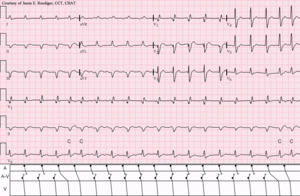Automatic tachycardia
An automatic tachycardia is a cardiac arrhythmia which involves an area of the heart generating an abnormally fast rhythm, sometimes also called enhanced automaticity. These tachycardias, or fast heart rhythms, differ from reentrant tachycardias (AVRT and AVNRT) in which there is an abnormal electrical pathway which gives rise to the pathology. Most automatic tachycardias are supraventricular tachycardias (SVT). It is important to recognise an automatic tachycardia because the treatment will be different to that for a reentrant tachycardia. The most useful clue will be the presence of 'warm up' and 'cool down'. This means that whereas a reentrant tachycardia will both begin and end abruptly as cardiac conduction utilises then ceases to utilise the accessory pathway, an automatic tachycardia will rise and fall gradually in rate as the automatic focus increases and decreases its automatic rate of electrical discharge.[1]
| Automatic tachycardia | |
|---|---|
 | |
| Junctional tachycardia (rate about 115/min) dissociated from a slightly slower sinus tachycardia (rate about 107/min). Junctional tachycardia is both an SVT and an automatic tachycardia |
Types
- Sinus tachycardia may be considered an automatic tachycardia, since the sinoatrial node (SAN) is discharging at an abnormally fast rate.
- Atrial ectopic tachycardia, in which the focus or foci are in the atria of the heart, is an automatic tachycardia.
- Atrial fibrillation may be considered an automatic tachycardia.
- Junctional ectopic tachycardia, in which the focus is in the atrioventricular node (AVN), and
- Accelerated idioventricular rhythm, involving a ventricular focus, are also examples. Idioventricular tachycardia is notable because it is the only automatic tachycardia which is not an SVT.
Treatment
Treatment depends on the origin of the automatic tachycardia, however the mainstay of treatment is either antidysrhythmic medication or cardiac pacing. Specifically overdrive pacing may be used for all forms of automatic tachycardia; a pacemaker assumes control of the heart rhythm in overdrive pacing. In some cases ablation of the ectopic focus may be necessary.
See also
References
- Lister B et al. Paediatric BASIC: Basic Assessment and Support in Paediatric Intensive Care. Department of Anaesthesia and Intensive Care of The Chinese University of Hong Kong, Hong Kong 2016.